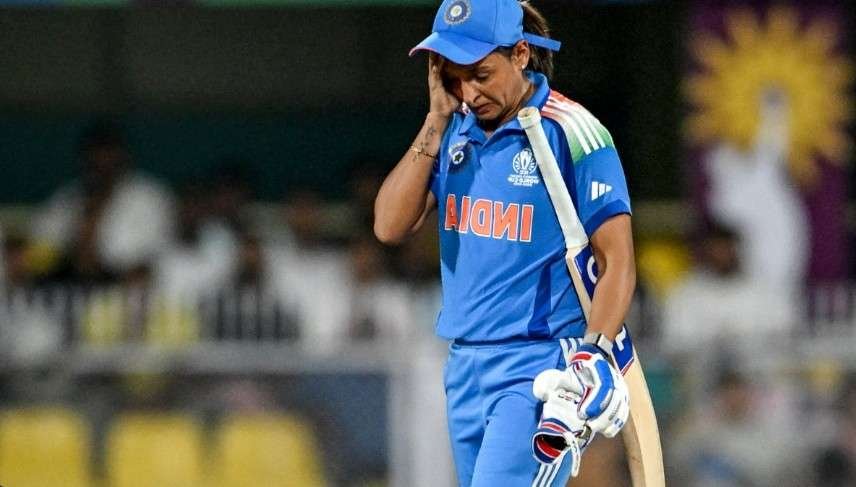India’s Women’s World Cup campaign has taken a worrying turn. Two successive defeats — first to South Africa, then to Australia — have not only imperiled India’s chances of reaching the semi-finals, but also triggered a fierce public backlash aimed at captain Harmanpreet Kaur. Critics argue her captaincy lacks clarity and her own batting form has been abysmal, and many now believe the Board of Control for Cricket in India (BCCI) should consider replacing her mid-tournament.
Tournament Woes, On and Off the Field
Entering the 2025 Women’s ODI World Cup, India were hopeful of a strong home run. But the campaign has sputtered badly. The defeat to South Africa exposed frailties in India’s approach, with the skipper lamenting that the batters “didn’t take responsibility.”
Then came the match against Australia — arguably India’s worst day — where despite posting 330, the team crumbled in the final overs. Australia chased down the target in a thrilling run chase, handing India a crushing defeat.
In that match, openers Smriti Mandhana (80) and Pratika Rawal (75) laid a solid foundation, but India collapsed, losing six wickets for just 36 runs in the final overs. Harmanpreet later said the first 40 overs were “really good” and blamed the “last six overs” for costing India the match. Increasingly, her post-match remarks have drawn criticism. She defended the team’s five-bowler strategy, insisting it had delivered success earlier, and maintained that two bad games shouldn’t lead to a rethink.
But she also singled out her own lower-order for failing to capitalise, suggesting that India “could have added 30–40 more runs.”
The Backlash Intensifies
Social media has overflowed with sharp criticism. Many users question how a captain can lecture others about accountability while her own runs have dried up.
Harsh comments include:
“Get rid of Harmanpreet Kaur as soon as possible. She alone is responsible for half of the problems, rarely scores … and behaves like Ellyse Perry.”
“She’s done a great job but isn’t it time the selectors chose a new leader for the team?”When Harmanpreet Kaur is getting sacked by BCCI who is captaining team India for more than a decade, got unlimited power & equal pay as men cricketers but didn’t won shit for India in ICC tournaments??
All she does is shouting at her juniors, shows unnecessory attitude to her… pic.twitter.com/pgisqMQBko
— Rajiv (@Rajiv1841) October 12, 2025
Critics also point to her on-field conduct — a nearly disastrous mix-up in the Australia match led to a heated exchange between Harmanpreet and Harleen Deol, drawing further scrutiny of her temperament. As for the numbers, Harmanpreet’s World Cup batting has been underwhelming: scores of 21, 19, 9, and 22 so far, without a single fifty. In contrast, teammates like Mandhana, Pratika Rawal, Jemimah Rodrigues, and Richa Ghosh have had better returns, further raising questions about leadership efficacy.
Coaching Staff Sound Alarm
India’s head coach Amol Mazumdar has also expressed unease. He admitted that the team earlier had “elongated discussions” about curbing dot balls (unused deliveries), and flagged that the dot-ball percentage has worsened. After the Australia loss, Mazumdar reiterated that while the dot-ball metric has improved slightly, it merits deeper scrutiny.
His comments suggest the coaching staff recognizes structural issues — not just individual form — as India’s strategy and execution are under increasing stress.
Harmanpreet Kaur has been captain of the Indian women’s cricket team for 12 years. She’s done a great job but isn’t it time the selectors chose a new leader for the team? Dhoni, Kohli, Rohit Sharma, Suryakumar, Gill…the men’s team has had quite a few, so what’s so special about… pic.twitter.com/IduX1YGWhm
— Mohan Sinha 🇮🇳 (@Mohansinha) October 12, 2025
What Lies Ahead?
With India’s semi-final hopes hanging by a thread, the path forward is narrow. They now must win all their remaining matches, and surpass other teams on net run rate, to make it into the top four.
Whether the BCCI will act mid-tournament remains unclear. Replacing a captain during a global event is a risky move — it can destabilise the setup, affect morale, and invite backlash of its own. But as public pressure mounts and internal confidence seems shaken, the board might consider whether a fresh voice could provide the spark India desperately needs.
In the balance now is much more than one captaincy decision — it is India’s chance to salvage pride, credibility, and a shot at the Women’s ODI World Cup crown.







